A positive outlook: What’s next for online learning and education?
While the world is disrupted with the COVID-19 outbreak, one of the most impacted industries is online learning and education. In just one day, several governments around the world ordered workplaces, schools, universities, and colleges to remain closed until further notice to avoid the spread of the virus. Common people, students, teachers, corporate trainers and employees, everyone was caught off-guard and realized that safety does matter first. But they managed to respond to the challenge in truly remarkable ways and started a change in the course of education that would last for a long time. The way these institutions adapted so quickly to these changes was nothing less than a revolution by using technology as the key enabler.
Updated on Apr 14, 2020
The COVID-19 induced a disruption that has placed online education and e-learning into the spotlight almost overnight. Until now, online education always remained in the back seat as an alternative to traditional, offline education. Even the most technologically forward-looking institutions and companies used a mixed approach of complementing offline learning with online re-learning. The temporary migration to 100% online consumption was quite instantaneous with the existing technology stack already in place.
Most of the enterprise training sessions, university lectures, classroom sessions used free tools like Google Classroom and Microsoft Teams to continue the learning process. Some companies like Zoom, even opened up their video conferencing platform free for learners and instructors. Many structured e-learning companies saw a huge spike of learners visiting their platforms to take new courses or continue their learning. The World Bank has even come up with a dedicated information portal outlining the importance of online learning and ways to accelerate it.
Why Digital Learning Matters?
There are several advantages that online learning provides when compared with the traditional methods of learning.
- Online learning can be accessed from the comfort of one’s home—especially during COVID-19 outbreak
- In a world of ever-increasing education costs, online learning saves a lot of money
- In a time-crunched lifestyle, self-paced learning helps save time
- Lectures can be repeated any number of times
- Content can be updated instantaneously
- Lessons and evaluation results are quickly delivered
- Digital learning has less impact on the environment.
- It democratizes education—anyone with an internet connection has access to information and materials
Completely replacing traditional models with online learning is a little too far fledged. What will happen is a continued adoption of digital learning along with the resumption of traditional paving ways for a hybrid learning environment.
Online learning is still in its infancy and will take time to race along with traditional classroom training. Classroom training inculcates presentation skills, collaboration skills, team spirit, cultural knowledge, listening skills which are important for any learner. However, as e-learning becomes more advanced with artificial intelligence, virtual reality and natural language processing among others, a major part of the classroom experience can be replicated to some extent.
Now that we have an idea of why online learning is significant, let’s dive into our analysis of the current state of e-learning and take a look at some of the best practices:
The State of E-learning Before COVID-19: The Story of a Laggard
The hardest part of learning something new is not embracing new ideas, but letting go of old ones. The education industry was always reluctant to embrace new technologies—even when other industries easily caught up with the modern internet era. In its report, the well-known educational industry research agency Holon IQ claims that education is the most under-digitized industry with only a fraction of the educational spending going into digitization.

Many e-learning startups have tried to make an impact, but there is still a mental hurdle involved in making the digital shift when it comes to education. However, COVID-19 has dissipated this mental prejudice by forcing learners to switch online. On March 17th, 2020, UNESCO (United Nations Educational, Scientific and Cultural Organization) revealed that more than 850 million students worldwide were not able to attend school due to the spreading outbreak. It’s important that the existing e-learning players step up their game to fill this urgent gap.
The Potential of E-learning: A Blossoming Opportunity
Holon IQ’s report paints an optimistic picture of the future for e-learning based on the investment numbers in the industry:
- Global digital spend in education will double in 2025 and is poised to touch $342B.
- Global edtech VC funding touched $7B in 2019, compared to a mere $0.5B in 2010.
- They are also predicting a tripling of investment in edtech over the next decade.
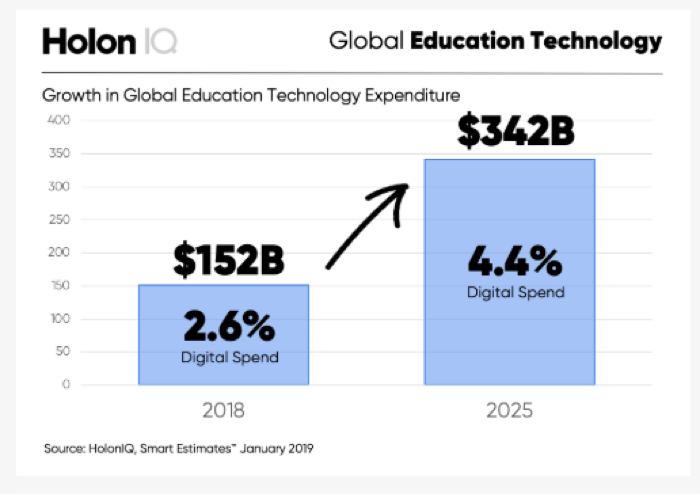
These projections are going to only improve after the impact of COVID-19. Structured e-learning platforms like Coursera, Udemy, Udacity have already seen a huge spike of learners looking for courses during the lockdown days. A few K-12-focused learning platforms like Byjus gave away its educational content for free and saw a 60% increase in app downloads. Ed-tech analysts foresee this as just the start of a bigger trend of higher digital adoption of the education industry.
A Positive Outlook: E-learning Companies During COVID-19
Many e-learning platforms have responded well to the increased demands and needs of online learning. The following is a list of immediate steps taken by a few global digital learning organizations as a response to the COVID-19 crisis.
1 – Opening Up Digital Learning For Everyone
The good news for established e-learning companies is that there is already a large number of users who are ready to embrace digital learning. As digital learning enablers, you should think of opening up your e-learning experiences to new users who are in dire need of help during the crisis. For example, Coursera for Campus initiative gives free access to any college or university that is impacted by the outbreak.
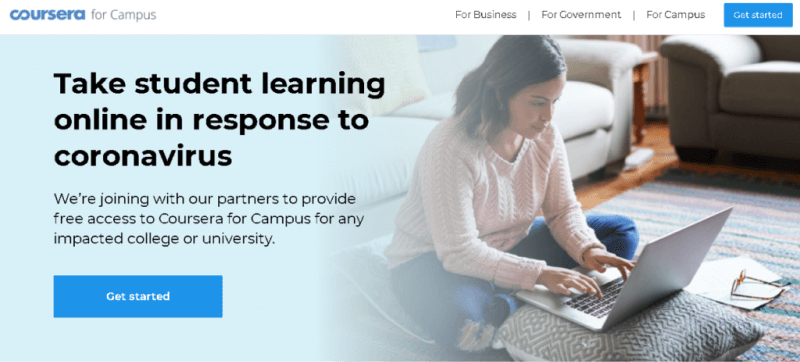
2- Providing Discounts for Your Courses
Now is the time to offer discounts on existing courses if you can. Such acts of empathy will go a long way in attracting and establishing a bond with your customers helping you build brand loyalty in the longer run. Simpliv is already offering 20% off on all their courses, and communicates this with customized banner promotions.

3- Personalized Discounts for COVID-Affected Users via Overlays
You can also add a personalization layer to your discounts and make sure it reaches the right beneficiaries. For example, Udacity offers personalized discounts to their customers by using a combination of website overlays with discount vouchers.
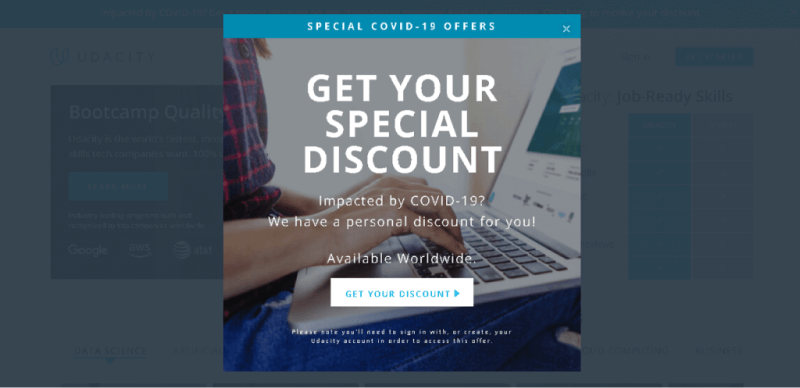
4 – Announcing Information and Policy Changes Due to COVID-19
Use homepage banners and sidebars to announce any new information, policy changes or new initiatives to the increasing number of visitors in your pages. Keeping your users updated on outbreak-related issues is very important in being transparent and showing that you care about your customers.
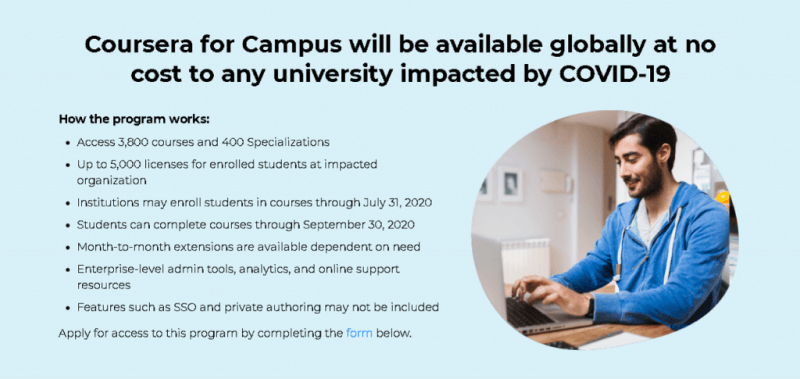
Set the Future of Digital-First Learning Experience
While most edu-tech companies are aware of their own importance during this crisis and already taking steps to lead the frontlines, much more needs to be done to enable the digitally-learning world of the future. Here we share a few easy strategies to make that happen.
- Addressing the Needs of COVID-times With Relevant Courses
It’s time to go beyond the obvious by leading the COVID-educational campaigns and taking care of your user’s learning needs at the same time. What about launching a dedicated COVID-certification to keep users safe from the virus? Add a certification opportunity with social share options to make your courses go viral.
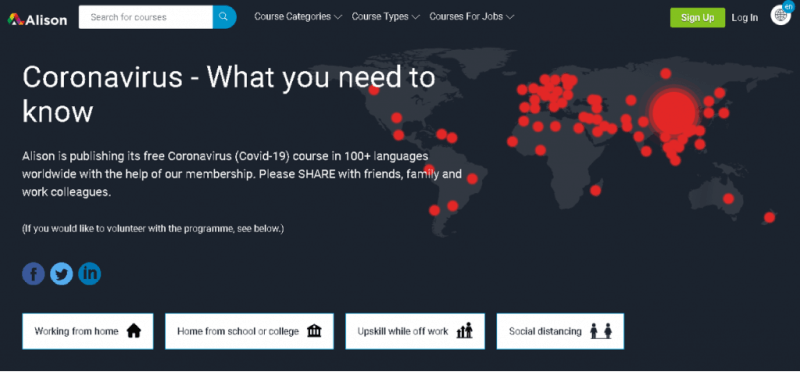
- Emphasize Your New Course as a Special Recommendation
Merely launching a new course or re-packaging existing courses may not be enough. Many of the new visitors will be new to digital learning and chances are high that they would be directly impacted by the pandemic. So it’s important to push your new course among the other courses by using a manual recommendation push.
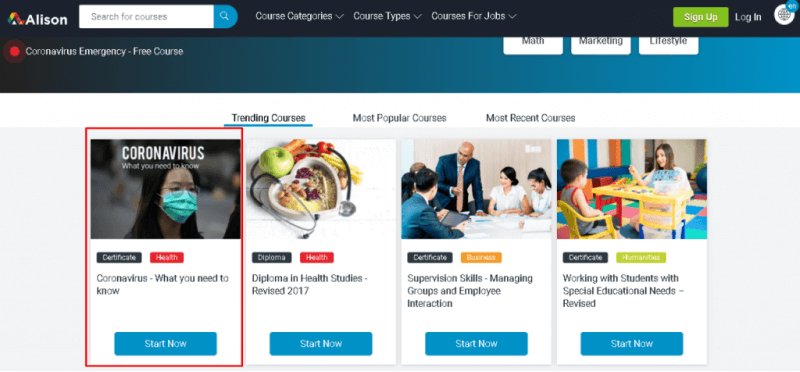
- Personalize Course Recommendations for Every User
You can also use smart recommendations to suggest relevant courses based on their needs and deliver personalized experiences. For example, Udemy suggests custom-packed courses based on user demographics and visit history.

- Promote Your Mobile App With Smart Banners
If you already have a mobile app, then it’s high time to promote it. For a start, place a smart banner on your website prompting users to download and try your application from Google Play or Apple Store.

- Customer Testimonials For Building Customer Trust
Getting more traffic is one thing, but converting that traffic into engaged customers is something else. You can reveal customer testimonials next to courses based on user interests to build trust and drive conversions. Showcasing how previous customers benefited from your courses can speed up the decision-making process of your potential new users.
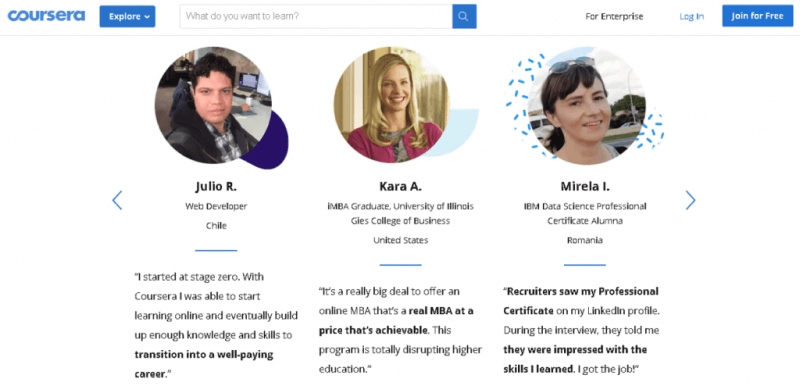
- Implement User Surveys In Your Web Portal For Selecting Tailored Courses
You can run a survey on your website to collect information on the wants and needs of your users and suggest the most relevant courses. Such surveys are very important when you have to cater to a variety of users with niche needs.
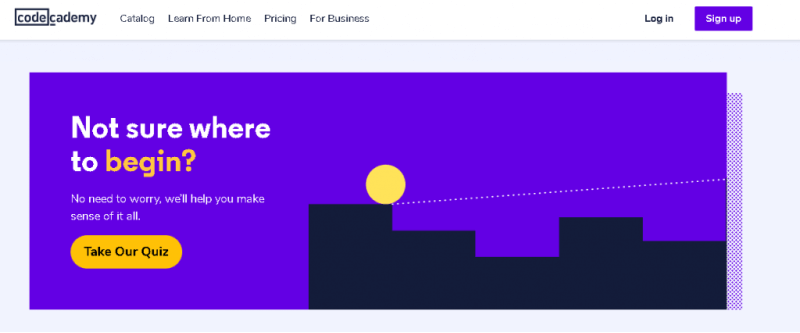
- Leverage the Power of Course Discovery Tools in Your Mobile Website & App
Conventional surveys might work well on desktops but may not provide the ideal experience on mobile devices. Make use of mobile product discovery tools like Maven for helping users to discover the best courses in a mobile-friendly format.

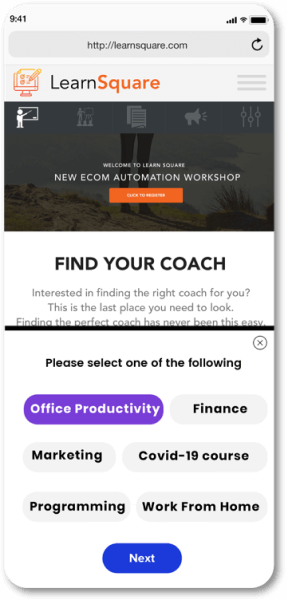
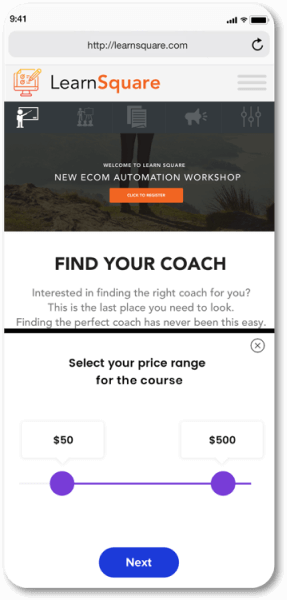
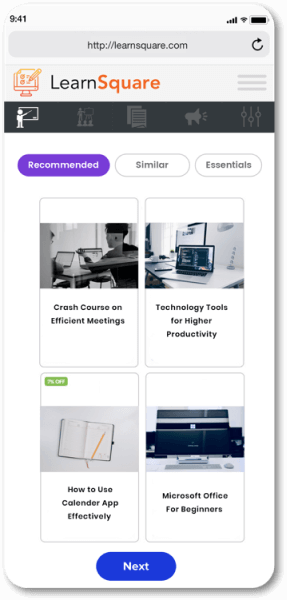
- Showcase Trending & Relevant Courses to Your Users
New users will need additional hand holding in terms of finding the courses they need. You can proactively suggest courses taken up by users that have a similar online behaviour. You can use AI-powered platforms to tap into the power of smart recommendation algorithms to deliver the idea journey at all stages of the customer lifecycle.

- Use the Power of Social Stories to Boost Engagement
Use Instagram-like stories to share e-learning tips, trending courses, educators with highest ratings, and user-specific recommendations in a way that users are familiar with from their social media habits. Use the power of stories! Tools like Insider’s InStory can help you create engaging stories within minutes and speed up course discovery.
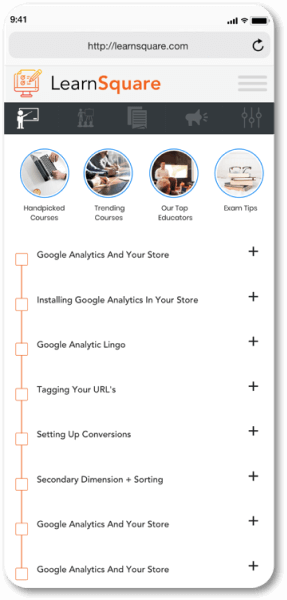

- Unleash the Power of Omnichannel Marketing
You can send learners notifications about onboarding tips, course materials, upcoming events, meetings, calls, course progress, and various other activities using app and web push notifications, email or SMS messages to keep them updated. To deliver great learning experiences you can use a customer journey mapping tool to create automated workflows for a seamless omnichannel experience.
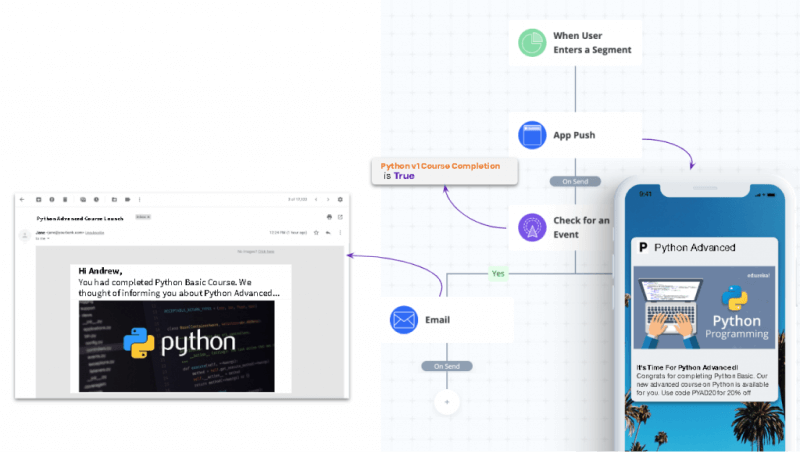
- AI-Powered E-learning Experience
With the number of users poised to increase multi-fold in the near future, it might be the right time to invest in AI-powered marketing technologies to take e-learning experiences to the next level amid increasing competition. See how Insider helps brands grow their metrics from acquisition to activation to retention and revenue while delivering meaningful multi-channel experiences, driving growth and loyalty.

Before You Go
For e-learning companies, Covid-19 might be a blessing in disguise. With a skyrocketing number of online learners and instantaneous fading away of the mental drag associated with digital learning, the adoption of edutech is going to become more mainstream than ever before. Now it’s up to edutech organizations to embrace this new digitally-learning world with high impact marketing and branding strategies.



















